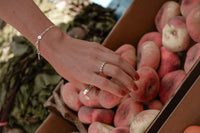Mined diamond behemoth De Beers has just announced that it will be entering the lab-grown diamond market, with a range of jewellery launching in September 2018. The reception has been somewhat chilly from the company’s diamond mining contemporaries, and the sectors of the jewellery industry which oppose man-made diamonds on principle have been scathing in the press. It is certainly interesting that De Beers, which has been vehemently opposed to lab-grown diamonds in the past, is now entering the market for themselves. Their press is making much of the fact that these are definitely not serious items of jewellery, and are marketed at the fun end of the jewellery-buying population. They are proclaiming that they will be selling the stones in such a way that there can be no confusion between lab-grown and mined diamonds, and won’t even be selling them through the same shops, or connected with the De Beers name. Other retailers of man-made diamonds, such as ourselves, have been making much of the distinction between lab-grown and mined diamonds, for many years, including the use of laser-etched serial numbers on the stones, so De Beers hasn’t invented that, despite trumpeting about their identification measures. Interestingly, De Beers makes a point in their publicity materials to say that the pricing will be ‘linear’. Now this is very interesting, as it is certainly the case that the pricing of mined diamonds is non-linear, confusing, and weighted heavily in favour of the retailer. It is recognised that the price of mined diamonds is fixed artificially high, and this emphasis by De Beers on their linear pricing now, could be viewed as an acknowledgement that the pricing of mined diamonds is indeed not fair.
SO, WHY HAVE THEY DONE IT?
There are a variety of possible reasons – firstly, their sources for mined diamonds are drying up. The company is investing heavily in mining for under-sea diamonds, and this could be part of the same trend – portfolio diversification. Another possibility is that they are attempting to branch into a market which is growing, and which they have been unable to fight. ‘If you can’t beat them, join them’ being a good strategy, they are now reaching out to Millennials, and others who would not touch a mined diamond with a ten-foot pole. Their pricing reflects this too, as they are using a variety of synonyms for the word 'cheap' without actually saying so. In all the publicity, De Beers are deliberately framing their new products as lighthearted, and not in any way a competitor to 'real' diamonds. It could be that they're trying to undermine the lab-grown diamond industry's positioning in relation to mined diamonds, something along the lines of 'yes, we can do this too, but they're not as good as the real ones we have over here'. However, savvy consumers will be aware that a lab-grown diamond is just as much a diamond as the mined equivalent, and not pay too much attention to De Beers' angle on the subject. However they like to portray their new range (and they’re carefully not calling it ‘ethical’ or ‘eco-friendly’) De Beers remains committed to land-based and under-sea mining of diamonds, which are not in any way ethical, or environmentally conscious activities. There would be an immediate out-cry if De Beers were to position themselves as ‘green’, so their new lab-grown range should not be viewed as an effort to clean up their act. For a truly environmentally friendly choice, yes, avoid mined diamonds, but also avoid De Beers, who are recognised internationally for their unethical treatment of workers, indigenous peoples, business rivals and the environment. View some of our other blogs about De Beers here: Undersea Diamond Mining De Beers, Blood Diamonds and Bitcoin





